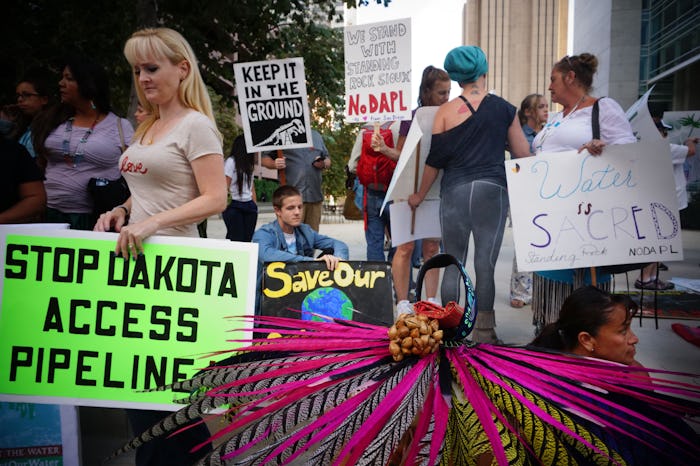News

Photos Of The Grand Central Standing Rock Protesters Show An Impassioned Group
Protests against the Dakota Access Pipeline have spread far beyond North Dakota and the Standing Rock Sioux Tribe. Now, protesters across the country are joining in to show solidarity with the Native Americans fighting for their land. Standing Rock protesters staged a demonstration in Grand Central in New York Tuesday morning.
The demonstration started with the words of African-American activist Assata Shakur in Grand Central Station, according to a reporter on the scene. Protests continued while policy and military officers surrounded the group, who then marched together to the Bank of America tower and JP Morgan building; both banks are funding construction of the pipeline. They've chanted "Water is life!" and demanded attention to their cause by demonstrating in heavily trafficked areas. Activists and journalists are using the hashtag #NYC2StandingRock to share information about the protests.
The demonstration comes after months of protests in North Dakota, where construction of the oil pipeline threatens the Sioux tribe's cultural, economic, and physical well being. The Dakota Access Pipeline, if construction is completed, will run from North Dakota through Iowa to Illinois, according to CNN. The pipeline was originally slated to cross through Bismarck, where more than 90 percent of residents are white. But those plans were changed due to concerns than an oil spill would ruin the city's drinking water. The pipeline was then moved to cross through the Sioux tribe's sacred spots and burial grounds, according to the Smithsonian Magazine. In addition to destroying sacred land, the pipeline would also endanger the Standing Rock Sioux tribe's water supply. Now, protesters across the country are stepping up to show solidarity with the Native Americans who want to protect their land.
Following are photos and videos of the New York protests posted by reporters, demonstrators, and passersby.
One North Dakota protester told NPR that the protests were about much more than the one oil pipeline.
It's about our rights as native people to this land. It's about our rights to worship. It's about our rights to be able to call a place home, and it's our rights to water.
The rights this protesters speaks of are documented in an 1851 treaty that gives Native American tribes the legal rights to their land. Protesters are arguing that the land on which the pipeline is being constructed is theirs, and that the construction company did not consult with the Sioux tribe before going forward with their plans, according to Vox.
Hundreds of protesters have been arrested since the movement began gaining momentum over the summer. Actress Shailene Woodley's October 10 arrest was highly publicized and talked about, thanks to a Facebook live video taken at the time of arrest. Since then, actors Mark Ruffalo and Susan Sarandon, among several others, have spoken out against construction of the oil pipeline, according to Fox News.
The Grand Central protesters are joining a long list of people who are now turning their attentions and their efforts to this issue. Masses of your Facebook friends are showing solidarity by checking in to Standing Rock, many have begun donating towards the bail of some arrested protesters, and mainstream media outlets have started covering the protests. It may seem like the movement against the Dakota Access Pipeline has been ongoing for some time — but with all this new momentum, it might just be getting started.